CBSE Sample Question Paper (2023-24) - 4 | Geography Class 11 - Humanities/Arts PDF Download
Time : 3 Hours
Maximum Marks : 80
General Instructions:
- This question paper contains 30 questions. All questions are compulsory.
- This question paper is divided into five sections. Sections – A, B, C, D and E.
- Section A – Question number 1 to 17 are Multiple Choice Type Questions carrying 1 mark each.
- Section B – Question number 18 and 19 are Source Based Questions carrying 3 marks each.
- Section C – Question number 2D to 23 are Short Answer Type Questions carrying 3 marks each. Answer to these questions shall be written in 80 to 100 words.
- Section D – Question number 24 to 28 are Long Answer Type Questions carrying 5 marks each. Answer to these questions shall be written in 120 to 150 words.
- Section E – Question number 29 and 30 are Map based questions.
Section – A
Q1. There are two statements marked as Assertion (A) and Reason (R). Mark your answer as per the codes provided
below. 1
Assertion: The air at the ITCZ rises because of convection caused by high insolation.
Reason: The winds from the tropics diverge at this low-pressure zone.
Options:
(A) Both (A) and (R) are true but (R) is not the correct explanation of (A)
(B) Both (A) and (R) are true and (R) is the correct explanation of (A)
(C) Both (A) and (R) are incorrect.
(D) (A) is correct but (R) is incorrect.
Ans: Option (B) is correct.
The air at the ITCZ rises because of convection caused by high insolation and a low- pressure zone is created where winds always converge.
Q2. Consider the following and choose the correct answer with the help of given codes: 1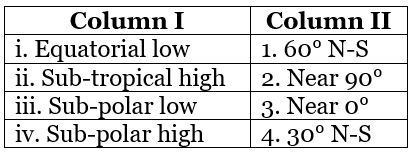
Options: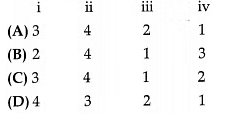
Ans: Qption (C) is correct.
- Equatorial low – (3) near 0°: Equatorial low-pressure systems are located near the equator, where warm air rises, creating a low-pressure area.
- Subtropical high – (4) 30° N-S: Subtropical high- pressure systems are situated around 30° latitude in both the northern and southern hemispheres, where descending cool air creates high-pressure zones.
- Sub-polar low – (1) 60°N-S: Subpolar low-pressure systems are found at around 60° latitude in both hemispheres, where warm air from the lower latitudes meets colder air from the polar regions.
- Sub-polar high – (2) near 90°: Subpolar high-pressure systems are located near the poles, where cold air sinks, creating a high-pressure area.
Q3. …………….. acts like a blanket allowing the earth neither to become too cold nor too hot. 1
(A) Dust particles
(B) Water vapour
(C) Ozone layer
(D) Carbon dioxide
Ans: Option (B) is correct.
Water vapour absorbs parts of insolation from the sun and preserves the earth’s radiated heat.
Q4. Consider the following statements and choose the correct answer with the help of the given options: 1
I. Growth in human population has increased the rate of consumption of natural resources.
II. Tropical regions occupy l/3rd of the total region of the world.
Options:
(A) Both statements are true.
(B) Only statement I is true.
(C) Only statement II is true.
(D) Both statements are wrong.
Ans: Option (B) is correct.
Growth in human population has increased the rate of consumption of natural resources which has accelerated the loss of species and habitation in different parts of the world.
Q5. Given below is a list of Natural vegetation and the type of trees found, identify which of the following pair is not correctly matched. 1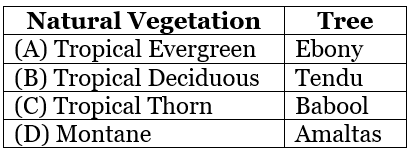
Ans: Option (D) is correct.
Montane forest is not matched with amaltas. Evergreen broad-leaf trees predominated mountain type of forest at an altitude of 1000 – 2000m.
Q6. The ………………. Geography was introduced by Alexander Von Humboldt. 1
(A) Systematic
(B) Physical
(C) Economic
(D) Regional
Ans: Option (A) is correct.
Alexander Von Humboldt introduced the concept of Systematic Geography, which emphasizes the categorization and study of various geographical phenomena based on their characteristics and relationships.
Q7. Which of the following scholars coined the term ‘Geography’: 1
(A) Herodotus
(B) Galileo
(C) Eratosthenes
(D) Aristotle
Ans: Option (C) is correct.
The term ‘Geography’ was coined by Eratosthenes, an ancient Greek scholar known for his contributions to geography and mathematics.
Q8. Which one of the following disciplines attempts temporal synthesis? 1
(A) Sociology
(B) Geography
(C) Anthropology
(D) History
Ans: Option (D) is correct.
History attempts temporal synthesis by studying and analysing past events, developments, and their relationships over time.
Q9. The stars are localised lumps of gas within a: 1
(A) nebula
(B) core
(C) gas
(D) hydrogen
Ans: Option (A) is correct.
Stars form from clouds of gas and dust called nebulae, where the gas becomes concentrated and eventually ignites into a star.
Q10. Consider the following statements and choose the correct answer with the help of given options: 1
Statement I: Heating by solar energy causes ocean water to expand.
Statement II: This causes a very slight gradient and water flows down the slope.
(A) Only statement I is correct
(B) Only statement II is correct
(C) Both the statements are correct, and statement II correctly explains statement I
(D) Both the statements are true but not related with each other
Ans: Option (C) is correct.
Near the equator, the ocean water is about 8 cm higher in level than in the middle latitude as heating of solar energy expands the ocean water.
Q11. Arrange the major underwater landforms in the correct order: 1
(i) Continental slope
(ii) Continental shelf
(iii) Oceanic deeps
(iv) Deep sea plain
Options:
(A) i, ii, iv, iii
(B) ii, iii, i, iv
(C) ii, i, iv, iii
(D) iii, i, ii, iv
Ans: Option (C) is correct.
Underwater landforms in order can be arranged as the continental shelf, continental slope, Deep sea plain and oceanic deeps.
Q12. Which one of the following figures represents the age of the earth? 1
(A) 4.6 million years
(B) 13.7 billion years
(C) 4.6 billion years
(D) 13.7 trillion years
Ans: Option (C) is correct.
The estimated age of the Earth is around 4.6 billion years, based on various scientific methods and evidence.
Q13. Caves having openings at both ends are called: 1
(A) stalactites
(B) tunnels
(C) sinkholes
(D) cave holes
Ans: Option (B) is correct.
Caves having openings at both ends are known as tunnels.
Q14. Which one of the following longitudes is the standard meridian for India: 1
(A) 69°30’E
(B) 82°30’E
(C) 75°30’E
(D) 90°30’E
Ans: Option (B) is correct.
The standard meridian for India is 82°30’E. This meridian, also known as the Indian Standard Time (IST) meridian, is used as the reference point for calculating Indian Standard Time across the country.
Study the following graph and answer questions no 15 to 17.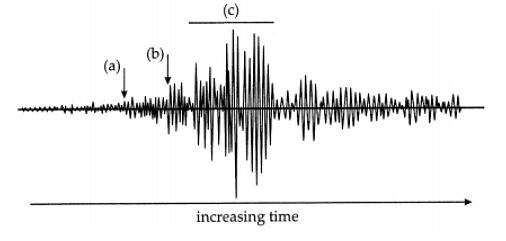
Q15. What is happening at point ‘a’? 1
(A) First arrival of P waves
(B) First arrival of S waves
(C) Last arrival of P waves
(D) Last arrival of S waves
Ans: Option (A) is correct.
Point ‘a’ represents the first arrival of P (Primary) waves, which are the fastest seismic waves and can travel through both solid and liquid layers of the Earth.
Q16. What is happening at point ‘b’? 1
(A) First arrival of S waves
(B) Last arrival of S waves
(C) First arrival of P waves
(D) Last arrival of P waves
Ans: Option (A) is correct.
Point ‘b’ indicates the first arrival of S (Secondary or Shear) waves, which are slower than P waves and can only travel through solid layers of the Earth.
Q17. What waves arrive over the interval labelled ‘c’? 1
(A) Q waves arrivals
(B) Surface waves arrivals
(C) Serial waves arrivals
(D) Seismic waves arrivals
Ans: Option (B) is correct.
Interval ‘c’ corresponds to the arrival of Surface waves, which include Love and Rayleigh waves. These waves cause the most noticeable ground shaking during an earthquake.
Section – B
Question 18 & 19 are Source based questions.
Q18. Read the given Passage carefully and answer the questions that follow: 3
Physical geography includes the study of the lithosphere (landforms, drainage, relief and physiography), atmosphere (its composition, structure, elements and controls of weather and climate; temperature, pressure, winds, precipitation, climatic types, etc.), hydrosphere (oceans, seas, lakes and associated features with water realm) and biosphere (life forms including human beings and macro-organisms and their sustaining mechanism, viz. food chain, ecological parameters and ecological balance). Soils are formed through the process of pedogenesis and depend upon the parent rocks, climate, biological activity, and time. Time provides maturity to soils and helps in the development of soil profiles. Each element is important for human beings. Landforms provide the base on which human activities are located. The plains are utilized for agriculture.
Plateaus provide forests and minerals. Mountains provide pastures, forests, and tourist spots and are sources of rivers providing water to lowlands. Climate influences our house types, clothing, and food habits. The climate has a profound effect on vegetation, cropping patterns, livestock farming some industries, etc. Human beings have developed technologies that modify climatic elements in a restricted space such as air conditioners and coolers. Temperature and precipitation ensure the density of forests and the quality of grasslands. In India, monsoonal rainfall sets the agriculture rhythm in motion. Precipitation recharges the groundwater aquifers, which later provide water for agriculture and domestic use.
a. Which shorelines have a remarkable and unmistakable match?
b. Tillite rocks are formed out of which deposits?
c. The glacial tillite provides unambiguous evidence of which type of climate?
Ans: a. Africa and South America
b. Glaciers
c. Paleo
Q19. Observe the below-given world map that shows the major ocean currents and answer the following. 3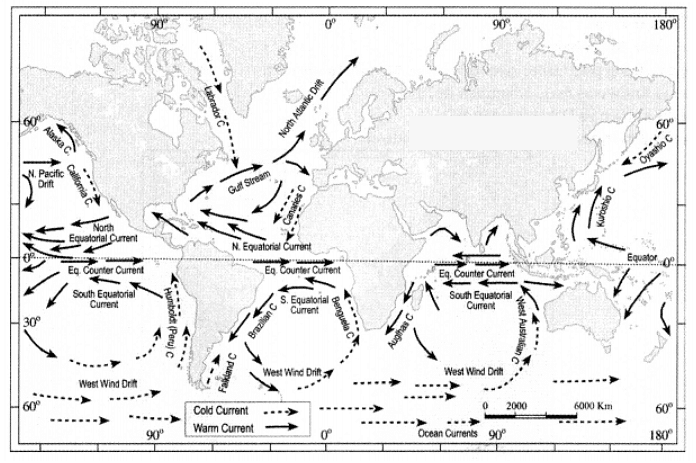 a. List any two currents that can be seen in the Indian Ocean.b. List out the cold currents that are seen in the Northern Hemisphere of the Atlantic Ocean.
a. List any two currents that can be seen in the Indian Ocean.b. List out the cold currents that are seen in the Northern Hemisphere of the Atlantic Ocean.
c. Name the current that is passing through Africa and Madagascar and what type of current it is?
Ans:
a. South Equatorial Current and West Australian Current.
b. Labrador currents and Canaries currents.
c. Agulhas current and it is a warm current.
Section – C
Question numbers 20 to 23 are Short Answer Type Questions.
Q20. What do you know about montane forests? 3
OR
Mention the characteristics of monsoonal rainfall in India.
Ans: In mountainous areas, the decrease in temperature with increasing altitude leads to a corresponding change in natural vegetation. Mountain forests can be classified into two types, the northern mountain forests and the southern mountain forests.
The Himalayan ranges show a succession of vegetation from the tropical to the tundra, which changes with altitude. Deciduous forests are found in the foothills of the Himalayas. It is succeeded by the wet temperate type of forests between an altitude of 1,000 – 2,000 m. Between 1,500 – 1,750 m, pine forests are also well-developed in this zone, with Chir Pine as a very useful commercial tree. Deodar, a highly valued endemic species grows mainly in the western part of the Himalayan range. Deodar is a durable wood mainly used in construction activities. Blue pine and spruce appear at altitudes of 2,225 – 3,048 m. But in the higher reaches, there is a transition to Alpine forests and pastures. Silver firs, junipers, pines, birch and rhododendrons, etc., occur between 3,000 – 4,000 m.
The southern mountain forests include the forests found in three distinct areas of Peninsular India viz; the Western Ghats, the Vindhyas and the Nilgiris. As they are closer to the tropics and only 1,500 m above the sea level, vegetation is temperate in the higher regions and subtropical on the lower regions of the Western Ghats, especially in Kerala, Tamil Nadu and Karnataka.
OR
The characteristics of monsoonal rainfall in India are:
(i) Rainfall received from the South-West monsoons is seasonal in nature, and occurs between June and September. The monsoon rainfall has a declining trend with increasing distance from the sea. For example, Kolkata receives 119cm of rain during the south-west monsoon whereas, Allahabad receives 76 cm.
(ii) The summer rainfall comes in a heavy downpour leading to considerable runoff and soil erosion. Monsoon also plays a pivotal role in the agrarian economy of India because over three-fourths of the total rain in the country is received during the South-west monsoon season.
(iii) The spatial distribution of monsoons across the country is uneven. It ranges from 12cm to more than 250 cm. The beginning of the rains sometimes is considerably delayed over the whole or a part of the country.
Q21. Explain the depositional landforms made by the winds. 3
Ans: The various depositional landforms made by wind are:
- Barchans: Crescent-shaped dunes called barchans with the points or wings directed away from wind direction i.e., downwind, form where the wind direction is constant and moderate and where the original surface over which sand is moving is almost uniform.
- Parabolic dunes: Parabolic dunes form when sandy surfaces are partially covered with vegetation. That means parabolic dunes are reversed barchans with wind direction being the same.
- Longitudinal dunes: Longitudinal dunes form when the supply of sand is poor and wind direction is constant. They appear as long ridges of considerable length but are low in height.
- Transverse dunes: They are aligned perpendicular to the wind direction. These dunes form when the wind direction is constant and the source of sand is an elongated feature at right angles to the wind direction. (Any three)

Q22. What are the primary forces that influence the currents? 3
OR
What are the characteristics of ocean currents?
Ans: The primary forces that influence the currents are:
- Heating by solar energy: It causes the water to expand. That is why, near the equator, the ocean water is about 8 cm higher in level than in the middle latitudes. This causes a very slight gradient and water tends to flow down the slope.
- Wind: Wind blowing on the surface of the ocean pushes the water to move. Friction between the wind and the water’s surface affects the movement of the water body in its course.
- Gravity: Gravity tends to pull the water down the pile and create gradient variation.
- The Coriolis force: It intervenes and causes the water to move to the right in the Northern Hemisphere and to the left in the Southern Hemisphere.
OR
purrents are referred to by their ’drift’. Usually, the currents are strongest near the surface and may attain speeds over five knots. At depths, currents are generally slow with speeds less than 0.5 knots. We refer to the speed of a current as its ‘drift’. Drift is measured in terms of knots. The strength of a current refers to the speed of the current. A fast current is considered strong. A current is usually strongest at the surface and decreases in strength (speed) with depth. Most currents have speeds less than or equal to 5 knots.
Q23. What do you know about India’s neighbours? 3
Ans: Pakistan, Nepal, Bhutan, Bangladesh along with India form a part of the Indian subcontinent. India is located in the south-central part of the continent of Asia, bordering the Indian Ocean and its two arms extending in the form of the Bay of Bengal and the Arabian Sea.
This maritime location of Peninsular India has provided links to its neighbouring regions through the sea and air routes. Sri Lanka and Maldives are two island countries located in the Indian Ocean, which are our neighbours.
Sri Lanka is separated from India by the Gulf of Mannar and the Palk Strait. Besides India also shares its boundary with China.
Section – D
Question numbers 24 to 28 are Long Answer Type Questions.
Q24. Explain tropical cyclones. 5
Ans: Tropical cyclones are violent storms that originate over oceans in tropical areas and move over to the coastal areas bringing about large-scale destruction caused by violent winds, very heavy rainfall and storm surges.
This is one of the most devastating natural calamities. They are known as Cyclones in the Indian Ocean, Hurricanes in the Atlantic, Typhoons in the Western Pacific and South China Sea, and Willy-willies in Western Australia. Tropical cyclones originate and intensify over warm tropical oceans. The conditions favourable for the formation and intensification of tropical storms are
- Large sea surface with a temperature higher than 27°C;
- Presence of the Coriolis Force;
- Small variations in the vertical wind speed;
- A pre-existing weak low-pressure area or low-level-cyclonic circulation;
- Upper divergence above the sea level system.
The energy that intensifies the storm, comes from the condensation process in the towering cumulonimbus clouds, surrounding the centre of the storm. With a continuous supply of moisture from the sea, the storm is further strengthened. On reaching the land the moisture supply is cut off and the storm dissipates. The place where a tropical cyclone crosses the coast is called the landfall of the cyclone. The cyclones, which cross 20°N latitude generally, re-curve and they are more destructive.
A mature tropical cyclone is characterised by the strong spirally circulating wind around the centre, called the eye. The diameter of the circulating system can vary between 150 and 250 km. The cyclone creates storm surges and they inundate the coastal lowlands. The storm peters out on the land.
Q25. Explain the essential features of the South West Monsoon Season. 5
Ans: Important features of the South West Monsoon Season:
(i) The southeast trade winds cross the equator and enter the Bay of Bengal and the Arabian Sea, only to be caught up in the air circulation over India. Passing over the equatorial warm currents, they bring with them moisture in abundance. After crossing the equator, they follow a south-westerly direction. That is why they are known as southwest monsoons.
(ii) The rain in the southwest monsoon season begins rather abruptly. One result of the first rain is that it brings down the temperature substantially.
(iii) This sudden onset of the moisture-laden winds associated with violent thunder and lightning, is often termed as the ‘break’ or ‘burst’ of the monsoon. The monsoon may burst in the first week of June in the coastal areas of Kerala, Karnataka, Goa and Maharashtra, while in the interior parts of the country, it may be delayed to the first week of July. The day temperature registers a decline of 5°C to 8°C between mid-June and mid-July.
(iv) As these winds approach the land, their southwesterly direction is modified by the relief and thermal low pressure over northwest India. The monsoon approaches the landmass in two branches: (i) The Arabian Sea branch (ii) The Bay of Bengal branch.
(v) The monsoon winds originating from the Arabian Sea are further divided into three branches: Its one branch is obstructed by the Western Ghats. Another branch of the Arabian Sea monsoon strikes the coast north of Mumbai. A third branch of this monsoon wind strikes the Saurashtra Peninsula and the Kachchh. The Bay of Bengal branch strikes the coast of Myanmar and part of southeast Bangladesh.
Q26. Explain with the help of a diagram how does the shadow zone emerge? 5
OR
What are the effects of the earthquake?
Ans: (i) Earthquake waves get recorded in seismographs located at far off locations. However, there exist some specific areas where the waves are not reported. Such a zone is called the ‘shadow zone’. The study of different events reveals that for each earthquake, there exists an altogether different shadow zone.
(ii) Seismographs located at any distance within 105° from the epicentre, recorded the arrival of both P and S-waves. However, the seismographs located beyond 145° from epicentre, record the arrival of P-waves, but not that of S-waves. Thus, a zone between 105° and 145° from epicentre was identified as the shadow zone for both the types of waves. The entire zone beyond 105° does not receive S-waves.
(iii) The shadow zone of S-waves is much larger than that of the P-waves. The shadow zone of P-waves appears as a band around the earth between 105° and 145° away from the epicentre. The shadow zone of S-waves is not only larger in extent but it is also a little over 40 per cent of the earth’s surface.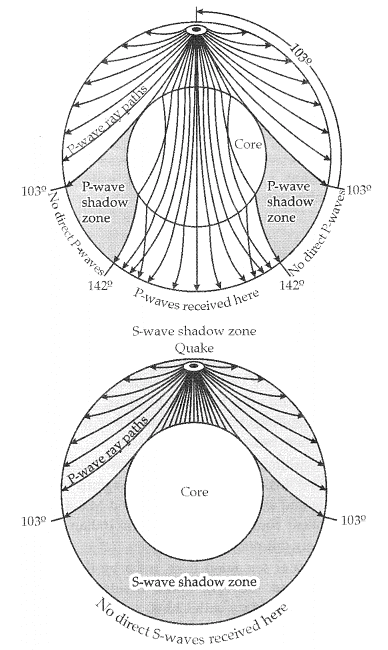 OREarthquake is a natural hazard. The following are the immediate hazardous effects of earthquakes:
OREarthquake is a natural hazard. The following are the immediate hazardous effects of earthquakes:
- Ground shaking: Ground shaking is a hazard created by earthquakes and also triggers for other hazards such as liquefaction and landslides. The ground shaking is caused due to the seismic waves passing beneath buildings, roads and other structures.
- Land and mud slides: When the earthquake occurs many times areas of steep slopes slip causing landslides. It also triggers mass movement of the soil.
- Destruction of means of communication and transportation: It leads to the destruction of means of communication and transportation. It creates problems in sending help and relief to the victims.
- Avalanches: Large earthquakes can trigger avalanches by suddenly cascading or dislodging the snow from the downside of the mountain which has catastrophic effects.
- Ground displacement: If a structure such as a building, road, etc., is built across a fault, the ground displacement during an earthquake could cause serious damage or rip apart that structure.
- Floods from dam and levee failures: An earthquake can rupture or break dams or levees along a river. The water from the river or the reservoir would then flood the area, damaging buildings and maybe sweeping away or drowning people.
- Fire: The fire can be started by broken gas lines and power lines or tipped over wood or coal stoves. There can be a serious problem, especially if the water lines that feed the hydrants are broken.
- Tsunami: By and large the most destructive tsunamis are generated from large, shallow earthquakes with an epicentre or fault line near or on the ocean floor. These usually occur in regions of the earth characterized by tectonic subduction along tectonic plate boundaries. (Any five)
Q27. Physical divisions of India are alternative to each other.’ Justify. 5
OR
Differentiate western coastal plain and eastern coastal plain.
Ans: The physical divisions of India are alternative to each other because:
(i) Himalayas are the storehouse of water as they rise to Perennial rivers which provide ample water for irrigation. Himalayas are also a source of forest produce and serve as a climatic divide.
(ii) The Northern Plains have fertile soil which is suitable for agriculture and also provides raw
materials for industries. The Northern Plains are also known as the ‘Food Bowl of India’.
(iii) Peninsular India is the storehouse of minerals, which are of great use to industries and are exported across the world. The Ghats are responsible for generating hydroelectricity.
(iv) The coastal plains are important for ports, the arrival of monsoons, international trade, and fishing etc. The coastal plains are world famous for the spices which are exported worldwide.
(v) The deserts are known as tourist attractions. The lakes and the playas have brackish water which is the main source of obtaining salt. The island group is known for the corals, volcanoes and are a major tourist destination. Thus, no part of India can grow and develop in isolation. They all are interdependent and cannot grow without each other. One part needs the support and cooperation of the other.
OR
Q28. How did the Peninsular Drainage System evolve? 5
OR
If you move from Badrinath to Sundarbans delta along the course of the river Ganga, what maj or geomorphological features will you come across?
Ans: Three major geological events in the distant past have shaped the present drainage systems of Peninsular India:
- Subsidence of the western flank of the Peninsula leading to its submergence below the sea during the early tertiary period. Generally, it has disturbed the symmetrical plan of the river on either side of the original watershed.
- Upheaval of the Himalayas when the northern flank of the Peninsular block was subjected to subsidence and the consequent trough faulting. The Narmada and The Tapi flow in trough faults and fill the original cracks with their detritus materials. Hence, there is a lack of alluvial and deltaic deposits in these rivers.
- Slight tilting of the Peninsular block from northwest to the southeastern direction gave orientation to the entire drainage system towards the Bay of Bengal during the same period.
OR
If you move from Badrinath to Sunderbans delta along the course of the river Ganga, we come across the following major geomorphological features:
(i) V-shaped valleys: Valleys start as small narrow rills, the rills will gradually develop into long and wide gullies, and the gullies will further deepen, widen and lengthen to give rise to valleys. Depending upon dimensions and shape, many types of valleys like v-shaped valleys, gorges, canyons, etc., can be recognised.
(ii) Gorge: A gorge is a deep valley with very steep to straight sides.
(iii) Canyon: A canyon is characterised by steep step-like slopes and may be as deep as a gorge. A gorge is almost equal in width at its top as well as at its bottom. In contrast, a canyon is wider at its top than at its bottom. In fact, a canyon is a variant of a gorge.
(iv) Waterfall: When the rivers start falling in pits in mountainous regions, it makes a waterfall.
(v) Plunge pools: Once a small and shallow depression forms, pebbles and boulders get collected in those depressions and get rotated by flowing water and consequently the depressions grow in dimensions. A series of such depressions eventually join and the stream valley gets deepened. At the foot of waterfalls also, large potholes, quite deep and wide, form because of the sheer impact of water and rotation of boulders. Such large and deep holes at the base of waterfalls are called plunge pools.
Section – E
Question numbers 29 & 30 are Map based questions having 5 sub-parts each.
Q29. Identify and label the following correct names of rivers with appropriate symbols on the given outline map of India with the help of the given information. 5
(i) It rises in Brahma Giri hills.
(ii) Sardar Sarovar Project.
(iii) Largest river in Rajasthan.
(iv) Westward flowing peninsular river originates from Betul district.
(v) This river is Known as Singi Khamban in Tibet.
(vi) This river is known as Dakshina ganga.
(vii) This river enters India through Arunachal Pradesh. Ans:
Ans: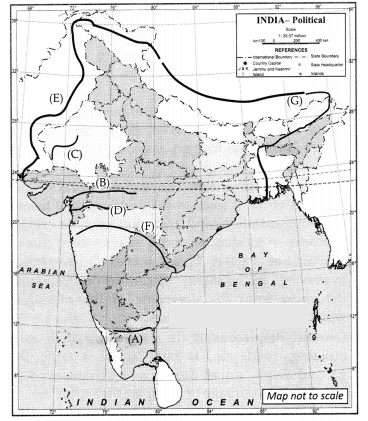 (A) Kaveri(B) Narmada
(A) Kaveri(B) Narmada
(C) Luni
(D) Tapi
(E) Indus
(F) Godavari
(G) Brahmaputra (Any five)
Q30. On an outline map of the world, mark any one area of the following: (Any five) 5
(i) AF-Tropical Wet Climate
(ii) DF- Cold Climate with Humid Winters
(iii) Cfb-Marine West Coast Climate
(iv) Cwa -Humid Subtropical Climate
(v) Aw-Tropical Wet and Dry Climate
(vi) Dw- Cold Climate with Dry Winters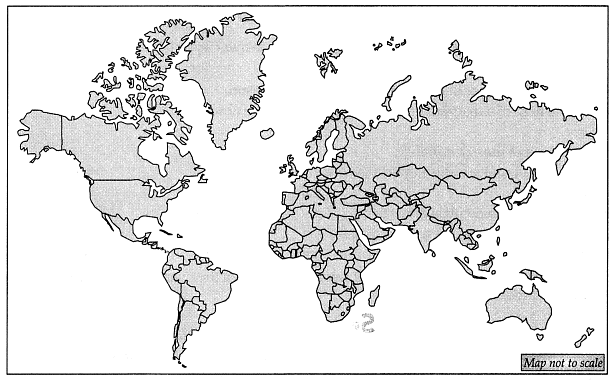 Ans:
Ans: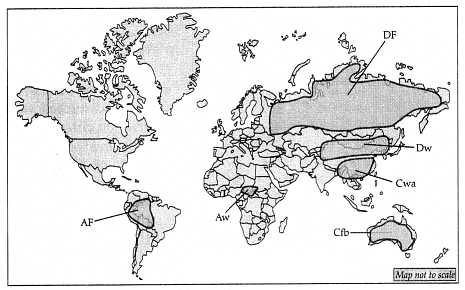 (A) AF-Tropical Wet Climate- Amazon Basin(B) DF- Cold climate with humid winters- Russia
(A) AF-Tropical Wet Climate- Amazon Basin(B) DF- Cold climate with humid winters- Russia
(C) Cfb-Marine West Coast Climate- Australia
(D) Cwa -Humid Subtropical Climate- South China
(E) Aw-Tropical Wet and Dry Climate-South of Central Africa
(F) Dw- Cold climate with dry winters – Northeastern Asia (Any five)
|
70 videos|289 docs|44 tests
|
FAQs on CBSE Sample Question Paper (2023-24) - 4 - Geography Class 11 - Humanities/Arts
| 1. How can studying humanities/arts subjects benefit students in their academic and professional careers? |  |
| 2. What are some popular career options for students who specialize in humanities/arts subjects? |  |
| 3. How can students effectively prepare for CBSE humanities/arts exams to score well? |  |
| 4. How can studying humanities/arts subjects contribute to personal growth and self-discovery? |  |
| 5. What are the key skills that students can develop through studying humanities/arts subjects? |  |





















